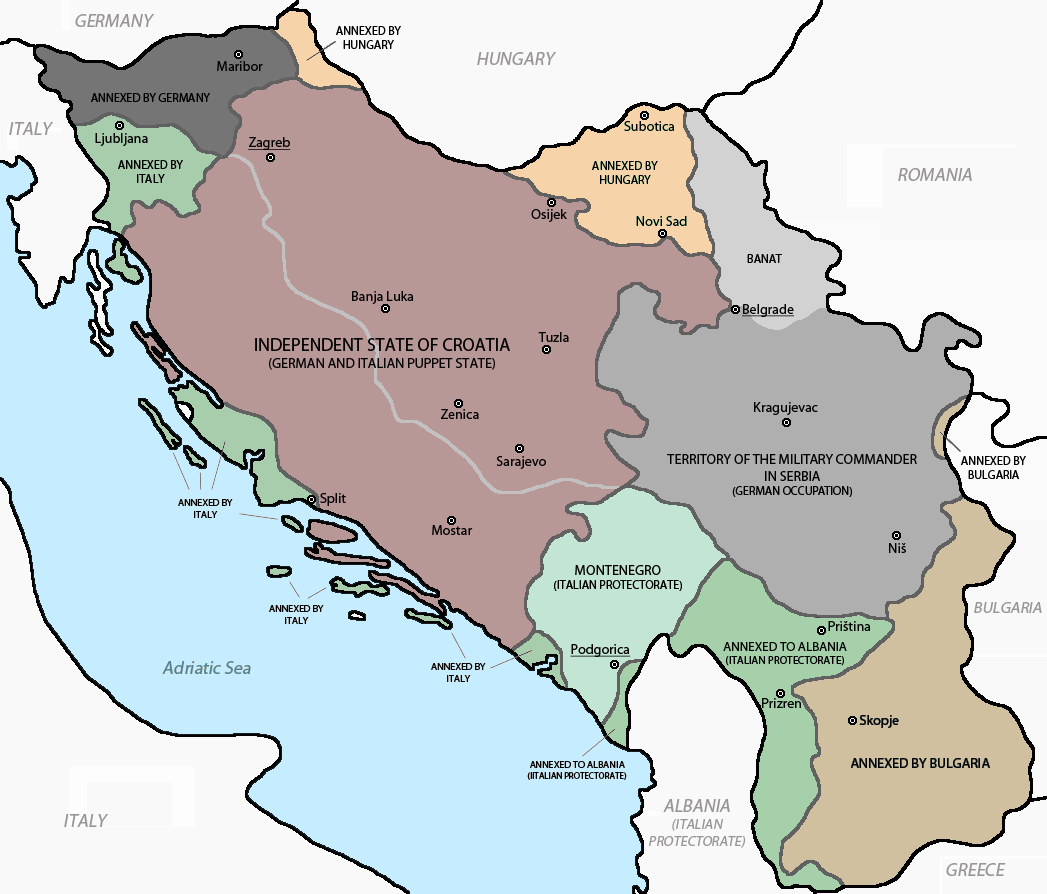|
Velibor Jonić
Velibor Jonić ( sr-Cyrl, Велибор Јонић; 12 February 1892 – 17 July 1946) was a Serbian fascist politician and government minister in the Territory of the Military Commander in Serbia during World War II. He taught at the Military Academy in Belgrade and at the Yugoslav royal court before the war. He was also the secretary-general of Zbor. He became the Serbian Commissioner of Education on 10 July 1941. He was tried of collaboration by the communists following the war and was sentenced to death. He was executed in July 1946. Early life Velibor Jonić was born on 12 February 1892 in Krnjevo, Kingdom of Serbia to Krsta and Sofia Jonić (''née'' Veljković). Before World War II, he taught at the Military Academy in Belgrade and worked as a journalist. He joined the Yugoslav National Movement ( sr, Jugoslovenski narodni pokret, Zbor) before the war and became its secretary-general. He also worked as a teacher in the royal court. He was married and had one child. ... [...More Info...] [...Related Items...] OR: [Wikipedia] [Google] [Baidu] |
Commissioner Government
The Commissioner Government (, ''Komesarska vlada'') was a short-lived Serbian collaborationist puppet government established in the German-occupied territory of Serbia within the Axis-partitioned Kingdom of Yugoslavia during World War II. It operated from 30 April to 29 August 1941, was headed by Milan Aćimović, and is also referred to as the Commissars Government or Council of Commissars. Of the ten commissioners, four had previously been ministers in various Yugoslav governments, and two had been assistant ministers. The members were pro-German, anti-semitic and anti- communist, and believed that Germany would win the war. The Aćimović government lacked any semblance of power, and was merely an instrument of the German occupation regime, carrying out its orders within the occupied territory. Under the overall control of the German Military Commander in Serbia, supervision of its day-to-day operations was the responsibility of the chief of the German administrative staff, ... [...More Info...] [...Related Items...] OR: [Wikipedia] [Google] [Baidu] |
Ministry Of Justice (Yugoslavia)
The Ministry of Justice of Yugoslavia refers to the justice ministry which was responsible for judicial system of the Kingdom of Yugoslavia from 1918 to 1941 and the communist SFR Yugoslavia from 1945 to 1992. It may also refer to the justice ministry of Serbia and Montenegro (officially named the Federal Republic of Yugoslavia) from 1992 to 2003. List of ministers Kingdom of Yugoslavia (1918–1941) Yugoslav government-in-exile (1941–1945) SFR Yugoslavia (1945–1992) FR Yugoslavia (1992–2003) See also *Ministry of Justice (Serbia) *Ministry of Justice (Croatia) *Ministry of Justice (Montenegro) External linksList of ministersat Rulers.org {{DEFAULTSORT:Ministry Of Justice (Yugoslavia) Government of Yugoslavia Yugoslavia Yugoslavia (; sh-Latn-Cyrl, separator=" / ", Jugoslavija, Југославија ; sl, Jugoslavija ; mk, Југославија ;; rup, Iugoslavia; hu, Jugoszlávia; rue, label=Pannonian Rusyn, Югославия, translit=J ... [...More Info...] [...Related Items...] OR: [Wikipedia] [Google] [Baidu] |
New Brunswick, New Jersey
New Brunswick is a city (New Jersey), city in and the county seat, seat of government of Middlesex County, New Jersey, Middlesex County, in the U.S. state of New Jersey.New Jersey County Map New Jersey Department of State. Accessed July 10, 2017. The city is the home of Rutgers University. The city is both a regional commercial hub for Central Jersey, central New Jersey and a prominent and growing commuter town for residents commuting to New York City within the New York metropolitan area. New Brunswick is on the Northeast Corridor, Northeast Corridor rail line, southwest of Manhattan. The city is located on the southern banks of the Raritan River in the Raritan Valley region. For 2020 United States census, 2020, New Brunswick had a population of 55,266 residents, [...More Info...] [...Related Items...] OR: [Wikipedia] [Google] [Baidu] |
College Station, Texas
College Station is a city in Brazos County, Texas, situated in East-Central Texas in the heart of the Brazos Valley, towards the eastern edge of the region known as the Texas Triangle. It is northwest of Houston and east-northeast of Austin. As of the 2020 census, College Station had a population of 120,511. College Station and Bryan make up the Bryan-College Station metropolitan area, the 13th-largest metropolitan area in Texas with 273,101 people as of 2019. College Station is home to the main campus of Texas A&M University, the flagship institution of the Texas A&M University System. The city owes its name and existence to the university's location along a railroad. Texas A&M's triple designation as a Land-, Sea-, and Space-Grant institution reflects the broad scope of the research endeavors it brings to the city, with ongoing projects funded by agencies such as NASA, the National Institutes of Health, the National Science Foundation, and the Office of Naval Research. ... [...More Info...] [...Related Items...] OR: [Wikipedia] [Google] [Baidu] |
Santa Barbara, California
Santa Barbara ( es, Santa Bárbara, meaning "Saint Barbara") is a coastal city in Santa Barbara County, California, of which it is also the county seat. Situated on a south-facing section of coastline, the longest such section on the West Coast of the United States, the city lies between the steeply rising Santa Ynez Mountains and the Pacific Ocean. Santa Barbara's climate is often described as Mediterranean climate, Mediterranean, and the city has been dubbed "The American Riviera". According to the 2020 United States census, U.S. Census, the city's population was 88,665. In addition to being a popular tourist and resort destination, the city has a diverse economy that includes a large service sector, education, technology, health care, finance, agriculture, manufacturing, and local government. In 2004, the service sector accounted for 35% of local employment. Education in particular is well represented, with four institutions of higher learning nearby: the University of Calif ... [...More Info...] [...Related Items...] OR: [Wikipedia] [Google] [Baidu] |
Vienna
en, Viennese , iso_code = AT-9 , registration_plate = W , postal_code_type = Postal code , postal_code = , timezone = CET , utc_offset = +1 , timezone_DST = CEST , utc_offset_DST = +2 , blank_name = Vehicle registration , blank_info = W , blank1_name = GDP , blank1_info = € 96.5 billion (2020) , blank2_name = GDP per capita , blank2_info = € 50,400 (2020) , blank_name_sec1 = HDI (2019) , blank_info_sec1 = 0.947 · 1st of 9 , blank3_name = Seats in the Federal Council , blank3_info = , blank_name_sec2 = GeoTLD , blank_info_sec2 = .wien , website = , footnotes = , image_blank_emblem = Wien logo.svg , blank_emblem_size = Vienna ( ; german: Wien ; ba ... [...More Info...] [...Related Items...] OR: [Wikipedia] [Google] [Baidu] |
Nikolaj Velimirović
Nikolaj Velimirović (Serbian Cyrillic: Николај Велимировић; – ) was bishop of the eparchies of Ohrid and Žiča (1920–1956) in the Serbian Orthodox Church. An influential theological writer and a highly gifted orator, he was often referred to as the new John Chrysostom and historian Slobodan G. Markovich calls him "one of the most influential bishops of the Serbian Orthodox Church in the twentieth century". As a young man, he came close to dying of dysentery and decided that he would dedicate his life to God if he survived. He lived and was tonsured as a monk under the name ''Nikolaj'' in 1909. He was ordained into the clergy, and quickly became an important leader and spokesperson for the Serbian Orthodox Church, especially in its relations with the West. When Nazi Germany occupied Yugoslavia in World War II, Velimirović was imprisoned and eventually taken to Dachau concentration camp. After being liberated by the Allies at the end of the war, he ... [...More Info...] [...Related Items...] OR: [Wikipedia] [Google] [Baidu] |
Gavrilo V, Serbian Patriarch
Gavrilo Dožić ( sr-cyr, Гаврило Дожић; 17 May 1881 – 7 May 1950), also known as Gavrilo V, was the Metropolitanate of Montenegro and the Littoral, Metropolitan of Montenegro and the Littoral (1920–1938) and the 41st Serbian Patriarch of the Serbian Orthodox Church, from 1938 to 1950. Early life Đorđe Dožić (Ђорђе Дожић) was born on 17 May 1881 in Kolašin Municipality, Vrujci, Kolašin, Lower Morača, Montenegro, near Morača Monastery. His family belonged to the Medenica brotherhood. He finished primary school at the monastery, as a pupil of his paternal uncle, archimandrite Mihailo. He went to theological schools in Prizren (Serbian Orthodox Seminary of Prizren, Seminary of Prizren) and the Prince Islands (Halki seminary). After that, he finished the theological faculty in Athens (National and Kapodistrian University of Athens, University of Athens). He worked as the secretary of the monastery of Hilandar. Bishop After bishop Nićifor Perić o ... [...More Info...] [...Related Items...] OR: [Wikipedia] [Google] [Baidu] |
Red Army
The Workers' and Peasants' Red Army (Russian: Рабо́че-крестья́нская Кра́сная армия),) often shortened to the Red Army, was the army and air force of the Russian Soviet Federative Socialist Republic and, after 1922, the Union of Soviet Socialist Republics. The army was established in January 1918. The Bolsheviks raised an army to oppose the military confederations (especially the various groups collectively known as the White Army) of their adversaries during the Russian Civil War. Starting in February 1946, the Red Army, along with the Soviet Navy, embodied the main component of the Soviet Armed Forces; taking the official name of "Soviet Army", until its dissolution in 1991. The Red Army provided the largest land force in the Allied victory in the European theatre of World War II, and its invasion of Manchuria assisted the unconditional surrender of Imperial Japan. During operations on the Eastern Front, it accounted for 75–80% of casual ... [...More Info...] [...Related Items...] OR: [Wikipedia] [Google] [Baidu] |
Soviet Union
The Soviet Union,. officially the Union of Soviet Socialist Republics. (USSR),. was a transcontinental country that spanned much of Eurasia from 1922 to 1991. A flagship communist state, it was nominally a federal union of fifteen national republics; in practice, both its government and its economy were highly centralized until its final years. It was a one-party state governed by the Communist Party of the Soviet Union, with the city of Moscow serving as its capital as well as that of its largest and most populous republic: the Russian SFSR. Other major cities included Leningrad (Russian SFSR), Kiev (Ukrainian SSR), Minsk ( Byelorussian SSR), Tashkent (Uzbek SSR), Alma-Ata (Kazakh SSR), and Novosibirsk (Russian SFSR). It was the largest country in the world, covering over and spanning eleven time zones. The country's roots lay in the October Revolution of 1917, when the Bolsheviks, under the leadership of Vladimir Lenin, overthrew the Russian Provisional Government ... [...More Info...] [...Related Items...] OR: [Wikipedia] [Google] [Baidu] |
Germany
Germany,, officially the Federal Republic of Germany, is a country in Central Europe. It is the second most populous country in Europe after Russia, and the most populous member state of the European Union. Germany is situated between the Baltic and North seas to the north, and the Alps to the south; it covers an area of , with a population of almost 84 million within its 16 constituent states. Germany borders Denmark to the north, Poland and the Czech Republic to the east, Austria and Switzerland to the south, and France, Luxembourg, Belgium, and the Netherlands to the west. The nation's capital and most populous city is Berlin and its financial centre is Frankfurt; the largest urban area is the Ruhr. Various Germanic tribes have inhabited the northern parts of modern Germany since classical antiquity. A region named Germania was documented before AD 100. In 962, the Kingdom of Germany formed the bulk of the Holy Roman Empire. During the 16th ce ... [...More Info...] [...Related Items...] OR: [Wikipedia] [Google] [Baidu] |






